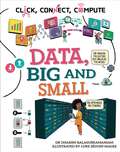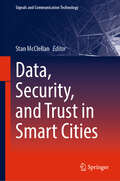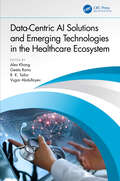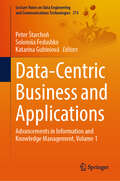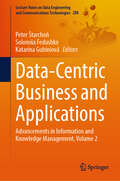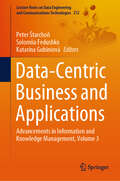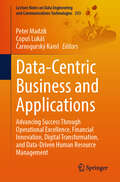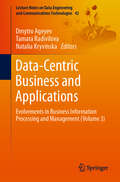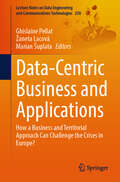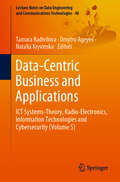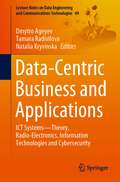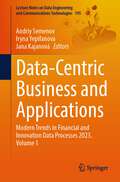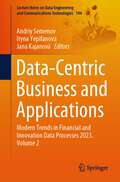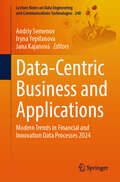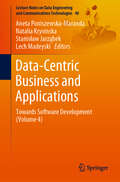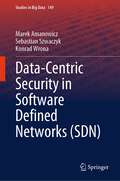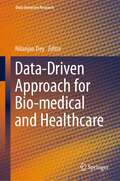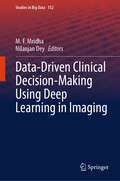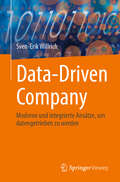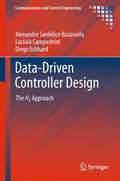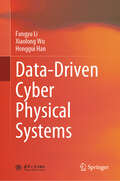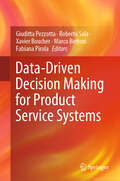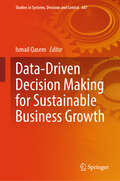- Table View
- List View
Data, Big and Small (Click, Connect, Compute #3)
by Dharini BalasubramaniamData science fundamentals, using clear, expert explanations and comic illustrations to spark interest and enthusiasm in the next generation of computer scientists!Data, Big and Small delves into the details behind computer science data and information, which help people and organisations to make decisions. Learn how and why data are created, stored and shared. Find out how we make sense of information through graphs, maps and pictures, and understand how machines learn from the data that we feed them. The end of the book fast-forwards to the future of computer science, data and robotics, and considers what it might mean to live in a 'smarter' world.Contents: What are data? / Data, information and knowledge / Data are vital / Where do data come from? / Getting the format right / Storing all those data / The value is in the processing / Picture it! / Big data / Getting the most out of data / Keeping data secure / A trip into the future of data ... / Pioneer portraits / Further information / Glossary / Quiz yourself! / IndexThe Click, Connect, Compute series untangles the computer science web and teaches children about the essentials of computer software, hardware and digital literacy as well as discussing the ethics surrounding this evolving field. Featuring fun, friendly comic strip illustrations, pioneer bios and a quiz, this is a perfect read for children aged 8+.Books in the series: Computer Science Essentials / Data, Big and Small / Smart Machines / The Languages of ProgrammingWritten in a clear, thoughtful way by computer science expert, Dr. Dharini Balasubramaniam, a strong advocate for ethics and education in her field.
Data, Security, and Trust in Smart Cities (Signals and Communication Technology)
by Stan McClellanThis book provides a comprehensive perspective on issues related to the trustworthiness of information in the emerging “Smart City.” Interrelated topics associated with the veracity of information are presented and discussed by authors with authoritative perspectives from multiple fields. The focus on security, veracity, and trustworthiness of information, data, societal structure and related topics in connected cities is timely, important, and uniquely presented. The authors cover issues related to the proliferation of disinformation and the mechanics of trust in modern society. Topical issues include trust in technologies, such as the use of machine learning (ML) and artificial intelligence (AI), the importance of encryption and cybersecurity, and the value of protecting of critical infrastructure. Structural issues include legal and governmental institutions, including the basis and importance of these fundamental components of society. Functional issues also include issues of societal trust related to healthcare, medical practitioners, and the dependence on reliability of scientific results. Insightful background on the development of AI is provided, and the use of this compelling technology in applications spanning networks, supply chains, and business practices are discussed by practitioners with direct knowledge and convincing perspective. These thought-provoking opinions from notable industry, academia, medicine, law, and government leaders provide substantial benefit for a variety of stakeholders.
Data-Centric AI Solutions and Emerging Technologies in the Healthcare Ecosystem
by Geeta Rana Alex Khang Vugar Abdullayev R. K. TailorThe book offers insight into the healthcare system by exploring emerging technologies and AI-based applications and implementation strategies. It includes current developments for future directions as well as covering the concept of the healthcare system along with its ecosystem. Data-Centric AI Solutions and Emerging Technologies in the Healthcare Ecosystem focuses on the mechanisms of proposing and incorporating solutions along with architectural concepts, design principles, smart solutions, decision-making process, and intelligent predictions. It offers state-of-the-art approaches for overall innovations, developments, and implementation of the smart healthcare ecosystem and highlights medical signal and image processing algorithms, healthcare-based computer vision systems, and discusses explainable AI (XAI) techniques for healthcare. This book will be useful to researchers involved in AI, IoT, Data, and emerging technologies in the medical industry. It is also suitable as supporting material for undergraduate and graduate-level courses in related engineering disciplines.
Data-Centric Business and Applications: Advancements in Information and Knowledge Management, Volume 1 (Lecture Notes on Data Engineering and Communications Technologies #213)
by Solomiia Fedushko Peter Štarchoň Katarína GubíniováThis book explores the profound impact of data on company operations, decision-making, and application development. The book delves into sophisticated information and knowledge management principles, including data governance, analytics, knowledge discovery, and artificial intelligence. The subject encompasses data-centric business models, emerging technology, and ethical considerations. Each chapter is authored by an expert in the area who offers important insights into the influence of data on the advancement of business and application development. The material herein is appropriate for a diverse audience, encompassing academics, practitioners, business professionals, and researchers. The editors sincerely appreciate the writers for their significant contributions, which have been crucial in developing an essential resource for studying and advancing data-centric businesses and applications.
Data-Centric Business and Applications: Advancements in Information and Knowledge Management, Volume 2 (Lecture Notes on Data Engineering and Communications Technologies #208)
by Solomiia Fedushko Peter Štarchoň Katarína GubíniováThis book stands out by exploring the significance of data in various aspects of business, including operations, decision-making, and application development, in a comprehensive and accessible manner. It delves into advanced topics such as data management, analytics, knowledge discovery, artificial intelligence, data-centric business models, emerging technologies, and ethical implications, providing a unique perspective. The book is appropriate for academics, professionals, and researchers with intermediate to advanced data management skills. Data plays a crucial role in today's rapidly evolving digital environment, serving as the foundation for businesses and the key element in driving innovation across diverse industries. This book delves into the latest advancements in data management, their impact on modern corporate settings, and advanced information and knowledge management concepts. The chapters in this book discuss various topics, including incorporating data-driven methods into business models, the difficulties and advantages of emerging technology, and the ethical aspects of making decisions based on data.
Data-Centric Business and Applications: Advancements in Information and Knowledge Management, Volume 3 (Lecture Notes on Data Engineering and Communications Technologies #212)
by Solomiia Fedushko Peter Štarchoň Katarína GubíniováEmbark on a journey into the future of business with a groundbreaking book that explores the dynamic interplay between data and business, unlocking its transformative power in strategy, decision-making, and application development. Dive deep into cutting-edge topics such as data governance, analytics, knowledge discovery, and AI, and gain an in-depth understanding of managing, analyzing, and extracting insights from complex data sets. This book's holistic approach sets this book apart, seamlessly integrating the latest information and knowledge management concepts. From integrating data-centric approaches into business models to addressing considerations in data-driven decisions, the diverse topics covered will provide invaluable insights into the central role of data in shaping the future of business and applications. This book sheds light on the ongoing advances in structural management, demonstrating how previously understood knowledge, technologies, and data can pave the way for sustainable solutions in the face of innovation, meet insight, and allow businesses to thrive in the digital age.
Data-Centric Business and Applications: Advancing Success Through Operational Excellence, Financial Innovation, Digital Transformation, and Data-Driven Human Resource Management (Lecture Notes on Data Engineering and Communications Technologies #253)
by Peter Madzík Copuš Lukáš Čarnogurský KarolThis book provides a comprehensive insight into contemporary management challenges shaped by digital transformation, operational excellence, and data-driven human resource strategies. It presents innovative frameworks for decision-making, workforce optimization, and financial innovation by integrating theoretical perspectives with real-world applications. With contributions from international scholars, it offers fresh perspectives on emerging technologies, sustainability, and business intelligence. Designed for academics, professionals, and policymakers, the book serves as a valuable resource for understanding and implementing effective management strategies in the digital era.
Data-Centric Business and Applications: Evolvements in Business Information Processing and Management (Volume 3) (Lecture Notes on Data Engineering and Communications Technologies #42)
by Natalia Kryvinska Dmytro Ageyev Tamara RadivilovaBuilding on the authors’ previous work, this book addresses key processes and procedures used in information/data processing and management. Modern methods of business information processing, which draw on artificial intelligence, big data, and cloud-based storage and processing, are opening exciting new opportunities for doing business on the basis of information technologies. Thus, in this third book, the authors continue to explore various aspects – technological as well as business and social – of the information industries. Further, they analyze the challenges and opportunities entailed by these kinds of business.
Data-Centric Business and Applications: How a Business and Territorial Approach Can Challenge the Crises in Europe? (Lecture Notes on Data Engineering and Communications Technologies #258)
by Ghislaine Pellat Marian Šuplata Žaneta LacováThe ERECO #European #Research #Community is an established network in interdisciplinary European research, bringing together 133 academics from 33 universities across the continent. Since 1994, ERECO has fostered a unique environment where economics, business, governance, technology, and culture meet to address the major transformations shaping Europe today. Driven by a belief that crises are moments for opportunity rather than decline, ERECO&’s researches offer forward-looking analyses on innovation, sustainability, regional resilience, and the future of work. Their collective expertise supports universities, public institutions, and businesses seeking to understand and anticipate Europe&’s next challenges. At a time when adaptability and vision are more critical than ever, ERECO positions itself as a strategic partner for those who aim to build a more resilient, inclusive, and future-ready Europe.
Data-Centric Business and Applications: ICT Systems-Theory, Radio-Electronics, Information Technologies and Cybersecurity (Volume 5) (Lecture Notes on Data Engineering and Communications Technologies #48)
by Natalia Kryvinska Dmytro Ageyev Tamara RadivilovaThis book addresses the challenges and opportunities of information/data processing and management. It also covers a range of methods, techniques and strategies for making it more efficient, approaches to increasing its usage, and ways to minimize information/data loss while improving customer satisfaction. Information and Communication Technologies (ICTs) and the Service Systems associated with them have had an enormous impact on businesses and our day-to-day lives over the past three decades, and continue to do so. This development has led to the emergence of new application areas and relevant disciplines, which in turn present new challenges and opportunities for service system usage. The book provides practical insights into various aspects of ICT technologies for service systems: Techniques for information/data processing and modeling in service systems Strategies for the provision of information/data processing and management Methods for collecting and analyzing information/data Applications, benefits, and challenges of service system implementation Solutions to increase the performance of various service systems using the latest ICT technologies
Data-Centric Business and Applications: ICT Systems—Theory, Radio-Electronics, Information Technologies and Cybersecurity (Lecture Notes on Data Engineering and Communications Technologies #69)
by Natalia Kryvinska Dmytro Ageyev Tamara RadivilovaThis book, building on the authors’ previous work, presents new communication and networking technologies, challenges and opportunities of information/data processing and transmission. It also discusses the development of more intelligent and efficient communication technologies, which are an essential part of current day-to-day life. Information and Communication Technologies (ICTs) have an enormous impact on businesses and our day-to-day lives over the past three decades and continue to do so. Modern methods of business information processing are opening exciting new opportunities for doing business on the basis of information technologies. The book contains research that spans a wide range of communication and networking technologies, including wireless sensor networks, optical and telecommunication networks, storage area networks, error-free transmission and signal processing.
Data-Centric Business and Applications: Modern Trends in Financial and Innovation Data Processes 2023. Volume 1 (Lecture Notes on Data Engineering and Communications Technologies #195)
by Andriy Semenov Iryna Yepifanova Jana KajanováThis book examines aspects of financial and investment processes, as well as the application of information technology mechanisms to business and industrial management, using the experience of the Ukrainian economy as an example. An effective tool for supporting business data processing is combining modern information technologies and the latest achievements in economic theory. The variety of industrial sectors studied supports the continuous acquisition and use of efficient business analysis in organizations. In addition, the book elaborates on multidisciplinary concepts, examples, and practices that can be useful for researching the evolution of developments in the field. Also, in this book, there is a description of analysis methods for making decisions in business, finance, and innovation management.
Data-Centric Business and Applications: Modern Trends in Financial and Innovation Data Processes 2023. Volume 2 (Lecture Notes on Data Engineering and Communications Technologies #194)
by Andriy Semenov Iryna Yepifanova Jana KajanováThis book examines aspects of financial and investment processes, as well as the application of information technology mechanisms to business and industrial management, using the experience of the Ukrainian economy as an example. An effective tool for supporting business data processing is combining modern information technologies and the latest achievements in economic theory. The variety of industrial sectors studied supports the continuous acquisition and use of efficient business analysis in organizations. In addition, the book elaborates on multidisciplinary concepts, examples, and practices that can be useful for researching the evolution of developments in the field. Also, in this book, there is a description of analysis methods for making decisions in business, finance, and innovation management.
Data-Centric Business and Applications: Modern Trends in Financial and Innovation Data Processes 2024 (Lecture Notes on Data Engineering and Communications Technologies #240)
by Andriy Semenov Iryna Yepifanova Jana KajanováThe combination of the latest developments in economic theory with contemporary information technologies may be considered as a powerful instrument for the processing of commercial data. This book employs the Ukrainian economy as a case study to examine the multifaceted aspects of financial and investment processes, as well as the utilization of information technology mechanisms in company and industrial management. The range of industrial sectors that have been investigated facilitates application of effective business analysis in enterprises. Furthermore, the book provides detailed insights into transdisciplinary ideas, practices, and examples that may be beneficial when examining evolutional developments in this area. Additionally, this book presents analytical techniques for decision-making in business, finance, and innovation management.
Data-Centric Business and Applications: Towards Software Development (Volume 4) (Lecture Notes on Data Engineering and Communications Technologies #40)
by Lech Madeyski Natalia Kryvinska Aneta Poniszewska-Marańda Stanisław JarząbekThis book explores various aspects of software creation and development as well as data and information processing. It covers relevant topics such as business analysis, business rules, requirements engineering, software development processes, software defect prediction, information management systems, and knowledge management solutions. Lastly, the book presents lessons learned in information and data management processes and procedures.
Data-Centric Security in Software Defined Networks (Studies in Big Data #149)
by Marek Amanowicz Sebastian Szwaczyk Konrad WronaThe book focuses on applying the data-centric security (DCS) concept and leveraging the unique capabilities of software-defined networks (SDN) to improve the security and resilience of corporate and government information systems used to process critical information and implement business processes requiring special protection. As organisations increasingly rely on information technology, cyber threats to data and infrastructure can significantly affect their operations and adversely impact critical business processes. Appropriate authentication, authorisation, monitoring, and response measures must be implemented within the perimeter of the system to protect against adversaries. However, sophisticated attackers can compromise the perimeter defences and even remain in the system for a prolonged time without the owner being aware of these facts. Therefore, new security paradigms such as Zero Trust and DCS aimto provide defence under the assumption that the boundary protections will be breached. Based on experience and lessons learned from research on the application of DCS to defence systems, the authors present an approach to integrating the DCS concept with SDN. They introduce a risk-aware approach to routing in SDN, enabling defence-in-depth and enhanced security for data in transit. The book describes possible paths for an organisation to transition towards DCS, indicating some open and challenging issues requiring further investigation. To allow interested readers to conduct detailed studies and evaluate the exemplary implementation of DCS over SDN, the text includes a short tutorial on using the emulation environment and links to the websites from which the software can be downloaded.
Data-Driven Analytics for the Geological Storage of CO2
by Shahab MohagheghData-driven analytics is enjoying unprecedented popularity among oil and gas professionals. Many reservoir engineering problems associated with geological storage of CO2 require the development of numerical reservoir simulation models. This book is the first to examine the contribution of artificial intelligence and machine learning in data-driven analytics of fluid flow in porous environments, including saline aquifers and depleted gas and oil reservoirs. Drawing from actual case studies, this book demonstrates how smart proxy models can be developed for complex numerical reservoir simulation models. Smart proxy incorporates pattern recognition capabilities of artificial intelligence and machine learning to build smart models that learn the intricacies of physical, mechanical and chemical interactions using precise numerical simulations. This ground breaking technology makes it possible and practical to use high fidelity, complex numerical reservoir simulation models in the design, analysis and optimization of carbon storage in geological formations projects.
Data-Driven Approach for Bio-medical and Healthcare (Data-Intensive Research)
by Nilanjan DeyThe book presents current research advances, both academic and industrial, in machine learning, artificial intelligence, and data analytics for biomedical and healthcare applications. The book deals with key challenges associated with biomedical data analysis including higher dimensions, class imbalances, smaller database sizes, etc. It also highlights development of novel pattern recognition and machine learning methods specific to medical and genomic data, which is extremely necessary but highly challenging. The book will be useful for healthcare professionals who have access to interesting data sources but lack the expertise to use data mining effectively.
Data-Driven Clinical Decision-Making Using Deep Learning in Imaging (Studies in Big Data #152)
by Nilanjan Dey M. F. MridhaThis book explores cutting-edge medical imaging advancements and their applications in clinical decision-making. The book contains various topics, methodologies, and applications, providing readers with a comprehensive understanding of the field's current state and prospects. It begins with exploring domain adaptation in medical imaging and evaluating the effectiveness of transfer learning to overcome challenges associated with limited labeled data. The subsequent chapters delve into specific applications, such as improving kidney lesion classification in CT scans, elevating breast cancer research through attention-based U-Net architecture for segmentation and classifying brain MRI images for neurological disorders. Furthermore, the book addresses the development of multimodal machine learning models for brain tumor prognosis, the identification of unique dermatological signatures using deep transfer learning, and the utilization of generative adversarial networks to enhance breast cancer detection systems by augmenting mammogram images. Additionally, the authors present a privacy-preserving approach for breast cancer risk prediction using federated learning, ensuring the confidentiality and security of sensitive patient data. This book brings together a global network of experts from various corners of the world, reflecting the truly international nature of its research.
Data-Driven Company: Moderne und integrierte Ansätze, um datengetrieben zu werden
by Sven-Erik WillrichDaten werden für Unternehmen immer wichtiger. Gleichzeitig mangelt es an Best Practices und Leitfäden, wie klassische mit modernen Ansätzen wie Data Mesh oder Data Fabric zu einem anwendbaren Framework integriert werden können. Hierzu werden die Themen Organisationsdesign, Datenstrategie / -management und Enterprise Architecture auf theoretische und pragmatische Weise verbunden. Das Buch präsentiert Ziele, ein Data Operating Model sowie datenstrategische Ansätze für eine Data-Driven Company. Hervorzuheben sind dabei die zahlreichen Abbildungen aus diesem Buch, die die komplexen Zusammenhänge anschaulich machen und das Lesen unterstützen. Zielgruppe Mit diesen Inhalten richtet sich das Buch an Führungskräfte, Experten, Berater und weitere Personen, die einen Bezug zur IT und Daten haben beziehungsweise diesen entwickeln möchten. Durch den niedrigschwelligen Einstieg und gleichzeitigen Tiefgang in die ausgewählten Themen adressiert es sowohl Einsteiger als auch erfahrene Datenexperten. Autor Dr. Sven-Erik Willrich ist ein erfahrener Experte im Bereich IT und Datenmanagement. Mit seinem Hintergrund in Wirtschaftsinformatik und langjähriger Beratungserfahrung bringt er sowohl theoretisches Wissen als auch praxisorientierte Lösungsansätze ein. Als Dozent und Redner im Bereich Digitalisierung teilt er regelmäßig seine Expertise.
Data-Driven Controller Design: The H2 Approach (Communications and Control Engineering)
by Lucíola Campestrini Diego Eckhard Alexandre Sanfelice BazanellaData-Based Controller Design presents a comprehensive analysis of data-based control design. It brings together the different data-based design methods that have been presented in the literature since the late 1990's. To the best knowledge of the author, these data-based design methods have never been collected in a single text, analyzed in depth or compared to each other, and this severely limits their widespread application. In this book these methods will be presented under a common theoretical framework, which fits also a large family of adaptive control methods: the MRAC (Model Reference Adaptive Control) methods. This common theoretical framework has been developed and presented very recently. The book is primarily intended for PhD students and researchers - senior or junior - in control systems. It should serve as teaching material for data-based and adaptive control courses at the graduate level, as well as for reference material for PhD theses. It should also be useful for advanced engineers willing to apply data-based design. As a matter of fact, the concepts in this book are being used, under the author's supervision, for developing new software products in a automation company. The book will present simulation examples along the text. Practical applications of the concepts and methodologies will be presented in a specific chapter.
Data-Driven Cyber Physical Systems
by Xiaolong Wu Fangyu Li Honggui HanThis book shows the exploration and integration of data-driven approaches within cyber-physical systems (CPS), focusing on how these systems leverage data science, artificial intelligence, and machine learning to enhance performance, optimize real-time decision-making, and improve the interaction between physical and digital components. Readers will be interested in the areas of data acquisition, integration, storage, modeling, simulation, fault detection, predictive maintenance, and cybersecurity. Because these topics highlight how data-driven approaches and advanced technologies can be applied to optimize system performance, enhance real-time decision-making, and ensure the safety and reliability of DDCPS. Additionally, practical applications across various industries demonstrate the real-world impact. The inclusion of real-world examples and practical applications helps bridge the gap between theory and practice, making the content highly relevant for professionals and researchers. Additionally, the book covers emerging trends and technologies, offering readers insights into the future of DDCPS. Readers will gain a comprehensive understanding of how to leverage data-driven approaches to enhance the performance and reliability of DDCPS.
Data-Driven Decision Making for Product Service Systems
by Xavier Boucher Giuditta Pezzotta Roberto Sala Marco Bertoni Fabiana PirolaThis book is a compilation of theoretical and practical contributions aimed at facilitating the servitization of manufacturing companies, specifically focusing on data-driven decision-making within the context of Product-Service Systems (PSS). Providing a comprehensive overview, it discusses the latest breakthroughs in operational, tactical, and strategic decision-making for PSS, leveraging data-driven processes, methodologies, and tools. Therefore, the book significantly contributes to strengthening the knowledge on the use of data-driven decision-making methods and tools all the phases of the PSS lifecycle.From extended warranties and leasing to pay-per-use and other innovative configurations, manufacturing companies are increasingly adopting servitized business models and PSS to create additional value for their customers and users and create robust relationships with them, ensuring more reliable cash flows. In this setting, effective information management and the utilization of aggregated operational data have become essential for guiding strategic, tactical, and operational decisions.This book not only consolidates theoretical frameworks but also offers practical insights into data-driven decision-making in PSS, providing deep knowledge on how complex decisions can be taken along the various phases of the PSS lifecycle using data-driven methods and tools. Key areas of focus include: 1. In the Beginning of Life, introducing new services tailored to customer needs, disclosing new business opportunities in terms of revenues, and extending the PSS Middle of Life.2. Designing or re-designing assets and/or services, thereby influencing the PSS Beginning of Life.3. Enhancing daily decisions related to asset management to improve the PSS Middle of Life.4. Optimizing daily decisions related to service delivery and management, aimed at enhancing the PSS Middle of Life.5. Facilitating informed decisions on recycling, remanufacturing, refurbishing, and revamping, impacting the PSS End of Life.This book will be of interest to researchers and managers in industry as it offers insights that bridge the gap between theory and practical application in the evolving landscape of PSS.
Data-Driven Decision Making for Sustainable Business Growth (Studies in Systems, Decision and Control #607)
by Ismail QasemThis book provides a comprehensive guide to data-driven decision-making for sustainable business growth. It offers practical insights and methodologies for leveraging data analytics to enhance sustainability initiatives and drive business success. Designed for business professionals, data scientists, and sustainability practitioners, the book bridges the gap between data science and sustainable business practices. By integrating data-driven strategies with sustainability goals, it addresses the critical need for informed decision-making in today's data-centric business environment. The main topics covered in this book include data analytics for sustainability, predictive modelling, big data applications, and the role of artificial intelligence in decision-making. These topics are crucial as they enable businesses to make informed decisions, optimize resource use, and improve overall sustainability performance. The book also explores case studies of successful data-driven sustainability initiatives, providing real-world examples and actionable insights. The relevance of these topics is significant in the modern business landscape, where data is a valuable asset. This book not only highlights the importance of data-driven decision-making for sustainability but also provides practical tools and techniques to implement these strategies effectively. It aims to empower businesses to harness the power of data for sustainable growth, enhancing their competitive advantage and contributing to a more sustainable future. The problem this book sets out to solve is the lack of clear guidance on integrating data analytics with sustainability initiatives. Many businesses struggle to utilize data effectively to achieve their sustainability goals. This book offers a roadmap for leveraging data to drive sustainable business practices, showcasing best practices and innovative approaches. The target audience for this book includes business leaders, data analysts, sustainability officers, researchers, and students in business and data science fields. By offering a blend of theoretical knowledge and practical applications, this book aims to equip readers with the skills needed to make data-driven decisions for sustainable business growth.
Data-Driven Decision Support System in Intelligent HealthCare
by Yu-Chen Hu Debnath BhattacharyyaMachine Intelligence with Generative AI is one of the most trending topics with applications in almost all fields of life. In healthcare, it is not only accelerating the development of new products, but also automating the generation of new and synthetic content making it easier to train and improve machine learning models.Some of the biggest achievements of Generative AI in healthcare have been drug discovery, personalized care, differentially private synthetic data generation, operational efficiency, and many more. Generative AI models like Generative Adversarial Networks, and Variational Autoencoders are employed to generate synthetic medical images, aiding in data augmentation, facilitating disease diagnosis, and enabling advanced medical imaging research. Additionally, Generative AI techniques are being utilized for creating realistic electronic health records (EHRs) and simulated patient data, supporting privacy-preserving data sharing, and empowering innovative studies for personalized medicine and drug development. NLP models like ClinicalBERT use transformer-based deep learning architecture to understand and represent contextual information in large clinical text datasets, such as electronic health records (EHRs) and medical literature, and can better grasp medical terminologies, domain-specific language, and contextual nuances that are unique to the healthcare field.This volume delves into the realm of Machine Intelligence with Generative AI and explores its impact on the healthcare industry.
